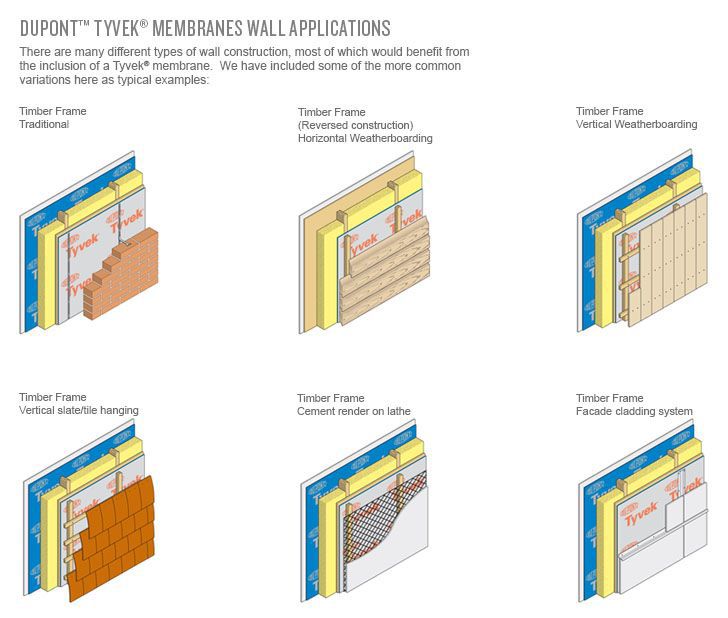Timber Frame Construction
Timber Frame Construction With Tyvek® and AirGuard®
Timber frame construction is popular due to its versatility, simplicity and light weight. DuPont™ Tyvek® building membranes work to make timber frame buildings even better – by improving their longevity and interior comfort.

Dual Challenges – Dual Protection
Timber frame construction structures need effective protection from two potential hazards: external weather and internal condensation. Tyvek® breather membranes and AirGuard® airtight membranes solve both issues at once – by allowing water vapour to escape through the outside building envelope, contributing to airtightness and reducing heat losses.
Application Types
Tyvek® and AirGuard® membranes are suitable for many types of timber frame construction. They help to protect the building fabric from moisture infiltration and increase thermal performance.
Efficient Protection From the Outside
To protect the insulation and the structure of the timber frame construction, installation of a vapour-open membrane is recommended.
Tyvek® protects the fabric of the building from rainwater penetration during construction before external claddings are completed. It also helps to air-seal the wall, and reduce heat loss. This aspect is likely to be of increasing importance as airtightness becomes more significant in thermal performance requirements under building regulations.
Tyvek® Housewrap, Tyvek® StructureGuard™, Reflex, Tyvek® e-Guard W1 and UV Façade more than satisfy the requirements for wall applications defined in BS 4016, and achieve resistance to water penetration to underlay standard EN 13859. And with DuPontTM Tyvek® FireCurb® breather membranes, DuPont is taking protection to the next level – by adding effective flame retardancy to the proven characteristics of Tyvek® membranes.
Efficient Protection From the Inside
For maximum energy efficiency and comfort, it is important to install an air and vapour control layer (AVCL) that will improve airtightness and reduce condensation. AirGuard® AVCLs are specially designed to eliminate uncontrolled air leakage, reducing convective heat loss and providing a highly-engineered vapour control system.
Uncontrolled air leakage occurs through gaps between and around insulation layers and through hairline cracks in plasterboard linings. These invariably occur during the building drying-out process, but are also caused by settlement and thermal movement over the life of the building. When installed continuously with all laps and penetrations sealed, AirGuard® AVCL membranes can provide a lasting solution to this issue in all building types.
AirGuard® AVCL membranes are 100% airtight. AirGuard® Control and AirGuard® Reflective are also completely water resistant. Offering highly engineered vapour control for internal walls, they meet requirements for EN 13984. So whether you use AirGuard® Control, Smart or Reflective AVCLs, you can be confident in their ability to control condensation and increase energy efficiency.
Accessories for Long-Term Performance
DuPont has developed a range of Tyvek® accessories to complement Tyvek® membranes and AirGuard® AVCLs, and give a complete holistic solution.
Tyvek® sealing tapes, including Tyvek® UV Façade Tape and Tyvek® FlexWrap NF, Tyvek® FlexWrap EZ are specifically designed to help seal the building envelope, reducing uncontrolled air leakage and providing long-term performance. Their excellent adhesion properties under extreme humidity mean they can be used on both interior and exterior walls.
Tyvek® Breather Membrane Solutions
Breather membranes play a key role in protecting buildings and occupants from the elements. Investing in a quality solution like DuPont™ Tyvek® can help provide long-term building protection – and peace of mind too.
Tyvek® & AirGuard® Sealing Tapes
Tyvek® and AirGuard® sealing tapes and accessories are specifically designed to complement Tyvek® breather membranes and AirGuard® air and vapour control membranes. They help to seal the building envelope, offering optimal airtightness, energy efficiency, long-term performance and durability.
AirGuard®: Vapour Control Layer Solutions
An AirGuard® vapour control layer can significantly reduce heat loss and increase energy efficiency. By controlling heat transfer and reflecting heat inside the building, they help keep buildings cool in summer, and warm in winter.
